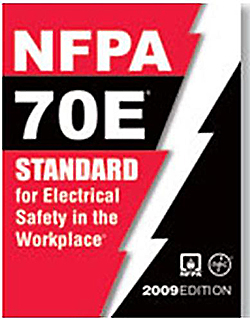
Electrical Safety Procedures are an essential part of any electrical safety program. Electrical workers must know where the disconnect switches and electrical panels are located in the workplace so that the electrical equipment can be quickly de-energized when an electrical accident occurs. Posting the location of the electrical panel on servicing equipment is also a great way to enhance electrical safety.
Establishing strict Electrical Safety Procedures must include properly labelling electrical equipment. This means that disconnect switches and electrical panels are clearly labeled and in clear view to show what equipment or power source that the electrical equipment control. At least three feet must be clear from obstruction at all times so that electrical panels can be safely operated and maintained.
Visit Our AF Course Page:
www.electricityforum.com/electrical-training/arc-flash-training
Electrical fires and electrical shock kill electrical workers every year, so it's important to establish and adhere to any set of established electrical safety procedures.
Electrical accidents can occur from overloaded circuits or wires. Sparks coming from electrical equipment can also ignite flammable vapors or other combustible materials. Unfortunately, most electrical incidents occur from electrical equipment misuse or from use of faulty electrical equipment. The following electrical safety procedures, which are set by the Occupational Safety and Health Administration (OSHA), can greatly reduce risk of an electrical incident.
Electrical Safety Procedures must include a way to prevent overloads by preventing overloaded wiring and circuits. This is to avoid arcs and overheating wires that can cause shock injuries and electrical fires.
Electrical Safety Procedures must include the Inspection of Electrical Equipment and insure all electrical equipment (power tools, extension cords, appliances, among others) are inspected before anyone uses them. Plugs and cords should be not twisted, abraded, frayed, worn, or corroded; exposed wires also shouldn’t be missing any ground pins. Live electrical parts have to be physically guarded or properly insulated. Damaged equipment with defective plugs or cords must not be used until fixed by a qualified electrician.
Comprehensive Electrical Safety Procedures include Checking Grounding Connections. Check all electrical outlets and be sure that they have a good grounding connection (plugs should be three-pronged plug and wires should be double-insulated).
Electrical Safety Procedures means using Highly-Qualified Electrical Personnel to ensure that wiring, electrical outlets and all the building’s electrical equipment are inspected, maintained and repaired by highly-qualified personnel (electricians, among others).
Electrical Safety Procedures also includes Working On De-Energized Equipment. This means checking to see that all electrical equipment is de-energized when work is done. Many electrical incidents occur because personnel try to work when electrical equipment is live. Ensure that plugs and cords are disconnected from all equipment and that no one else can reactivate this equipment until all work is done. When servicing is being done on hard-wired equipment, the circuit breaker has to be turned off and locked and tagged with a tag and special padlock. Work on live equipment can only be done by electricians with Lockout/Tagout training.
Most Electrical Safety Procedures include a way to isolate Flammables, Solvents and Chemicals from a point of ignition. This means a way to Isolate all organic solvents and corrosive chemicals from electrical cords because they can easily erode wires and the insulation. With that in mind, also isolate materials that can easily catch on fire away from electrical equipment.
Electrical Safety Procedures also means keeping Electrical Equipment Dry to insure that all electrical equipment is kept away from damp or wet locations (unless equipment is specifically rated for these conditions) and Electrical Safety Procedures include keeping the electrical workplace dry. By doing this, you reduce the risk of an electrical incident by ensuring that your feet, hands and body are free from perspiration or dampness when operating electrical equipment. Also, never operate electrical equipment when you’re standing on a wet floor.
Electrical Safety Procedures includes Calling 911 In Case Of an Electrical Fire. Abandon your work area and call 911 if an electrical fire occurs. Also, trigger the fire alarm and do not attempt to put the electrical fire out using water. The proper fire extinguisher used is “ABD” or “C.” Only shut down the main power source if it’s safe and possible to do so.
Electrical Safety Proceduresalso include avoiding Contact With Shock Victims. Avoid touching anyone (or any kind of electrical equipment) that falls victim to electrical shock. Call 911 immediately so that the person can be treated by a fire fighter or paramedic. Only shut down the main power source if it’s safe and possible to do so.